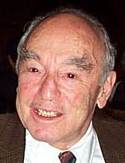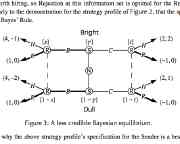
“I had had brilliant students at Stanford and ditto at Notre Dame; and, of course, I had several of that impressive ilk the visiting year at Oberlin. What struck me most forcefully, however, was the serious approach to their own education widely evinced by even run-of-the-mill Oberlin students — a phenomenon I had not experienced at either Stanford or Notre Dame.”
— Robert Weinstock
(1919–2006)

UC Berkeley’s economics department has been singularly prominent in antitrust of late — recognized particularly during the Clinton administration.
Five Berkeley profs who served as Deputy Assistant Attorneys General for Economic Analysis (the highest economist post within the Department of Justice’s Antitrust Division): Joe Farrell (L), Mike Katz, Rich Gilbert, Carl Shapiro, and Dan Rubinfeld.
Basic Training
I graduated in 1974 from, believe it or not, Friendly Senior High in, again believe it or not, Friendly, Maryland.
Hilda Rosenstock was a monumental math teacher! Way over qualified for her position (she co-authored “Vibrations of a Simple Cube Lattice. II” in the Journal of Chemical Physics), she taught calculus with a level of rigor you won’t find in undergraduate curricula until the junior/senior real-analysis/advanced-calculus level. Also notably, she refused to let me be the underachiever I was vigorously trying to be.
I proudly attended Oberlin College, graduating in 1979 with a double major in physics and math. I’m a strong proponent of undergraduate-only liberal-arts schools like Oberlin. The professors there were excellent and very dedicated to their teaching, rather than distracted by publish and perish.
Robert Weinstock (bio #1, bio #2), very much a traditional old-school professor, was very influential in my training in mathematics, reinforcing my penchant for rigor. Among other courses, I took a small (six-student) course in advanced problem solving from him. The focus wasn’t just on proving a proposition or arriving at an answer; it was on developing problem-solving creativity by striving to find as many different ways and perspectives to do so as possible.
BTW, George Simmons’ Differential Equations with Applications and Historical Notes communicated in an inspiring and impactful-for-me way the concept of a long sequence of giants, each standing on the shoulders of previous giants, responsible for building our current edifice of mathematical and physical-science knowledge.
Daniel Davy Merrill was an incredibly effective catalyst for my engagement with technical philosophy. He brought problems that grabbed me and he was very open to and appreciative of my contributions. (I was close to adding a minor in philosophy to my double major.)
Mad scientist
From immediately after graduating from Oberlin, until December 1985, I worked as a physicist (and very much as a scientific programmer), conducting research in underwater acoustics, at Applied Research Laboratories at the University of Texas at Austin.
Who needs C++? I could program anything in FORTRAN! I was also ARL’s self-appointed Mac Evangelist. (ARL — to its credit — was an early, nay immediate, adopter of the Macintosh in 1984.)
I hit a ceiling at ARL: I’d gone as far as I could without a graduate degree, so…
Berzerkeley grad student
I entered the graduate economics program at the University of California at Berkeley in the fall of 1986. (Moving from physics to graduate-level economics was not the huge leap many thought. Economics at that level is very laden with applied math. In fact, I think physics is an ideal undergraduate background for economics.)
I specialized in microeconomic theory generally and in game theory and industrial organization more specifically. I TA-ed the graduate theory sequence for PhD students; an excellent undergrad game-theory course taught by Matt Rabin; and an undergrad mathematical economics course taught by Gerard Debreu. I worked one summer for George Akerlof, Janet Yellen, and Andy Rose on what turned into their “Waiting for Work” paper. Although by this time Drew Fudenberg had left Berkeley for MIT, I provided research assistance for his and Jean Tirole's game-theory textbook.
With Fred Kofman, accepting a problem posed by Tom Marschak, I also pioneered very interesting, but harder to categorize, research on optimal communication when communication is costly.
That paper, plus ones on indefinitely repeated games and renegotiation-proof equilibrium, turned into my dissertation. My dissertation advisor was Rich Gilbert. Rich and I met up again a few years later (see “Back to the Bay Area” below) to begin a very productive collaboration that continues today.
I moved from Berkeley to Tucson (see next paragraph) in August 1992, officially receiving my PhD in economics from Berkeley in the spring of 1993.
Sonoran Desert professor
In August 1992 I moved to Tucson, Arizona to become an assistant professor in the Economics Department in the College of Business and Public Administration (BPA), at the University of Arizona. I was hired by Mark Walker, now chair, who had already done a great job putting together a theory group and later revitalizing the department more generally.
My research was all in game theory, primarily developing the theory of repeated games.
My classroom activities were principally teaching game theory to advanced PhD candidates (download lecture notes) and intermediate microeconomic theory to upper-division undergraduate economics majors. I less frequently taught microeconomic theory to incoming PhD students; game theory to upper-division undergraduate economics majors; and “economic analysis for business decisions” to upper-division undergraduate business students.
Back to the Bay Area via the private sector
I resigned from the University of Arizona at the end of the Fall 1997 semsester in order to join LECG, Inc. (formerly the Law & Economics Consulting Group, now LECG LLC) in Emeryville, California (in the East Bay of the San Francisco Bay Area), where I was a Senior Managing Economist in LECG’s antitrust practice area, providing expert economic analysis in support of antitrust litigation.
In October 2006, I left LECG to become a Vice President at Competition Policy Associates (a k a COMPASS) in their San Francisco office. The folks at COMPASS were so welcoming and flexible that they accommodated my desire to have a Mac in their otherwise all-Windoze environment. With my dual 23-inch Cinema Displays, I am one happy camper!

“Womb chairs” at Oberlin’s Mudd Library. I wrote quite a Nietzsche essay in one of those!

An example from Perfect Bayesian Equilibrium in Sender-Receiver Games from the online notes from my graduate course in game theory. Currently Google Ranked #1 for “perfect bayesian”

When Apple announced Macintosh in 1984, I immediately knew it was the personal computer I’d been waiting for. I’ve been a steadfast evangelizer for the Mac ever since.
The Mac’s handling of fonts and graphics made it the perfect instrument for writing papers with mathematical notation. My handouts were legendary.

I was an early adopter of the noncommerial web. My professor/personal pages won a top-3 honor at the University of Arizona in 1995